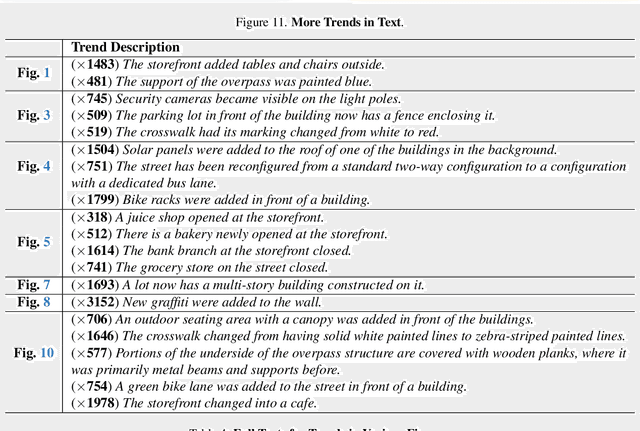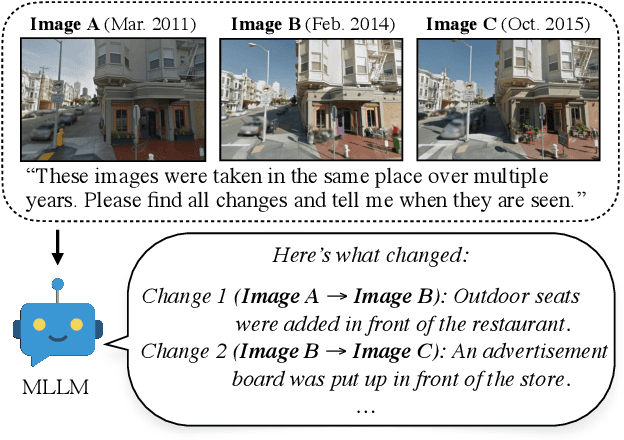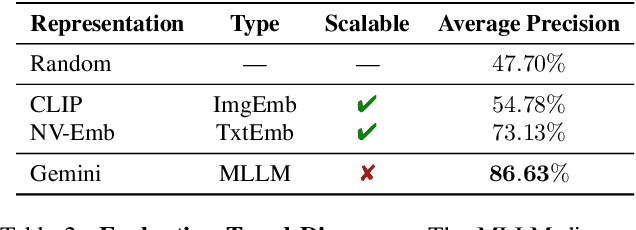Noah Snavely
Cornell Tech
Eye2Eye: A Simple Approach for Monocular-to-Stereo Video Synthesis
Apr 30, 2025Abstract:The rising popularity of immersive visual experiences has increased interest in stereoscopic 3D video generation. Despite significant advances in video synthesis, creating 3D videos remains challenging due to the relative scarcity of 3D video data. We propose a simple approach for transforming a text-to-video generator into a video-to-stereo generator. Given an input video, our framework automatically produces the video frames from a shifted viewpoint, enabling a compelling 3D effect. Prior and concurrent approaches for this task typically operate in multiple phases, first estimating video disparity or depth, then warping the video accordingly to produce a second view, and finally inpainting the disoccluded regions. This approach inherently fails when the scene involves specular surfaces or transparent objects. In such cases, single-layer disparity estimation is insufficient, resulting in artifacts and incorrect pixel shifts during warping. Our work bypasses these restrictions by directly synthesizing the new viewpoint, avoiding any intermediate steps. This is achieved by leveraging a pre-trained video model's priors on geometry, object materials, optics, and semantics, without relying on external geometry models or manually disentangling geometry from the synthesis process. We demonstrate the advantages of our approach in complex, real-world scenarios featuring diverse object materials and compositions. See videos on https://video-eye2eye.github.io
Visual Chronicles: Using Multimodal LLMs to Analyze Massive Collections of Images
Apr 14, 2025



Abstract:We present a system using Multimodal LLMs (MLLMs) to analyze a large database with tens of millions of images captured at different times, with the aim of discovering patterns in temporal changes. Specifically, we aim to capture frequent co-occurring changes ("trends") across a city over a certain period. Unlike previous visual analyses, our analysis answers open-ended queries (e.g., "what are the frequent types of changes in the city?") without any predetermined target subjects or training labels. These properties cast prior learning-based or unsupervised visual analysis tools unsuitable. We identify MLLMs as a novel tool for their open-ended semantic understanding capabilities. Yet, our datasets are four orders of magnitude too large for an MLLM to ingest as context. So we introduce a bottom-up procedure that decomposes the massive visual analysis problem into more tractable sub-problems. We carefully design MLLM-based solutions to each sub-problem. During experiments and ablation studies with our system, we find it significantly outperforms baselines and is able to discover interesting trends from images captured in large cities (e.g., "addition of outdoor dining,", "overpass was painted blue," etc.). See more results and interactive demos at https://boyangdeng.com/visual-chronicles.
Beyond the Frame: Generating 360° Panoramic Videos from Perspective Videos
Apr 10, 2025Abstract:360{\deg} videos have emerged as a promising medium to represent our dynamic visual world. Compared to the "tunnel vision" of standard cameras, their borderless field of view offers a more complete perspective of our surroundings. While existing video models excel at producing standard videos, their ability to generate full panoramic videos remains elusive. In this paper, we investigate the task of video-to-360{\deg} generation: given a perspective video as input, our goal is to generate a full panoramic video that is consistent with the original video. Unlike conventional video generation tasks, the output's field of view is significantly larger, and the model is required to have a deep understanding of both the spatial layout of the scene and the dynamics of objects to maintain spatio-temporal consistency. To address these challenges, we first leverage the abundant 360{\deg} videos available online and develop a high-quality data filtering pipeline to curate pairwise training data. We then carefully design a series of geometry- and motion-aware operations to facilitate the learning process and improve the quality of 360{\deg} video generation. Experimental results demonstrate that our model can generate realistic and coherent 360{\deg} videos from in-the-wild perspective video. In addition, we showcase its potential applications, including video stabilization, camera viewpoint control, and interactive visual question answering.
FlashDepth: Real-time Streaming Video Depth Estimation at 2K Resolution
Apr 09, 2025Abstract:A versatile video depth estimation model should (1) be accurate and consistent across frames, (2) produce high-resolution depth maps, and (3) support real-time streaming. We propose FlashDepth, a method that satisfies all three requirements, performing depth estimation on a 2044x1148 streaming video at 24 FPS. We show that, with careful modifications to pretrained single-image depth models, these capabilities are enabled with relatively little data and training. We evaluate our approach across multiple unseen datasets against state-of-the-art depth models, and find that ours outperforms them in terms of boundary sharpness and speed by a significant margin, while maintaining competitive accuracy. We hope our model will enable various applications that require high-resolution depth, such as video editing, and online decision-making, such as robotics.
Can Generative Video Models Help Pose Estimation?
Dec 20, 2024Abstract:Pairwise pose estimation from images with little or no overlap is an open challenge in computer vision. Existing methods, even those trained on large-scale datasets, struggle in these scenarios due to the lack of identifiable correspondences or visual overlap. Inspired by the human ability to infer spatial relationships from diverse scenes, we propose a novel approach, InterPose, that leverages the rich priors encoded within pre-trained generative video models. We propose to use a video model to hallucinate intermediate frames between two input images, effectively creating a dense, visual transition, which significantly simplifies the problem of pose estimation. Since current video models can still produce implausible motion or inconsistent geometry, we introduce a self-consistency score that evaluates the consistency of pose predictions from sampled videos. We demonstrate that our approach generalizes among three state-of-the-art video models and show consistent improvements over the state-of-the-art DUSt3R on four diverse datasets encompassing indoor, outdoor, and object-centric scenes. Our findings suggest a promising avenue for improving pose estimation models by leveraging large generative models trained on vast amounts of video data, which is more readily available than 3D data. See our project page for results: https://inter-pose.github.io/.
Stereo4D: Learning How Things Move in 3D from Internet Stereo Videos
Dec 12, 2024Abstract:Learning to understand dynamic 3D scenes from imagery is crucial for applications ranging from robotics to scene reconstruction. Yet, unlike other problems where large-scale supervised training has enabled rapid progress, directly supervising methods for recovering 3D motion remains challenging due to the fundamental difficulty of obtaining ground truth annotations. We present a system for mining high-quality 4D reconstructions from internet stereoscopic, wide-angle videos. Our system fuses and filters the outputs of camera pose estimation, stereo depth estimation, and temporal tracking methods into high-quality dynamic 3D reconstructions. We use this method to generate large-scale data in the form of world-consistent, pseudo-metric 3D point clouds with long-term motion trajectories. We demonstrate the utility of this data by training a variant of DUSt3R to predict structure and 3D motion from real-world image pairs, showing that training on our reconstructed data enables generalization to diverse real-world scenes. Project page: https://stereo4d.github.io
Doppelgangers++: Improved Visual Disambiguation with Geometric 3D Features
Dec 08, 2024



Abstract:Accurate 3D reconstruction is frequently hindered by visual aliasing, where visually similar but distinct surfaces (aka, doppelgangers), are incorrectly matched. These spurious matches distort the structure-from-motion (SfM) process, leading to misplaced model elements and reduced accuracy. Prior efforts addressed this with CNN classifiers trained on curated datasets, but these approaches struggle to generalize across diverse real-world scenes and can require extensive parameter tuning. In this work, we present Doppelgangers++, a method to enhance doppelganger detection and improve 3D reconstruction accuracy. Our contributions include a diversified training dataset that incorporates geo-tagged images from everyday scenes to expand robustness beyond landmark-based datasets. We further propose a Transformer-based classifier that leverages 3D-aware features from the MASt3R model, achieving superior precision and recall across both in-domain and out-of-domain tests. Doppelgangers++ integrates seamlessly into standard SfM and MASt3R-SfM pipelines, offering efficiency and adaptability across varied scenes. To evaluate SfM accuracy, we introduce an automated, geotag-based method for validating reconstructed models, eliminating the need for manual inspection. Through extensive experiments, we demonstrate that Doppelgangers++ significantly enhances pairwise visual disambiguation and improves 3D reconstruction quality in complex and diverse scenarios.
MegaSaM: Accurate, Fast, and Robust Structure and Motion from Casual Dynamic Videos
Dec 05, 2024



Abstract:We present a system that allows for accurate, fast, and robust estimation of camera parameters and depth maps from casual monocular videos of dynamic scenes. Most conventional structure from motion and monocular SLAM techniques assume input videos that feature predominantly static scenes with large amounts of parallax. Such methods tend to produce erroneous estimates in the absence of these conditions. Recent neural network-based approaches attempt to overcome these challenges; however, such methods are either computationally expensive or brittle when run on dynamic videos with uncontrolled camera motion or unknown field of view. We demonstrate the surprising effectiveness of a deep visual SLAM framework: with careful modifications to its training and inference schemes, this system can scale to real-world videos of complex dynamic scenes with unconstrained camera paths, including videos with little camera parallax. Extensive experiments on both synthetic and real videos demonstrate that our system is significantly more accurate and robust at camera pose and depth estimation when compared with prior and concurrent work, with faster or comparable running times. See interactive results on our project page: https://mega-sam.github.io/
Generating 3D-Consistent Videos from Unposed Internet Photos
Nov 20, 2024



Abstract:We address the problem of generating videos from unposed internet photos. A handful of input images serve as keyframes, and our model interpolates between them to simulate a path moving between the cameras. Given random images, a model's ability to capture underlying geometry, recognize scene identity, and relate frames in terms of camera position and orientation reflects a fundamental understanding of 3D structure and scene layout. However, existing video models such as Luma Dream Machine fail at this task. We design a self-supervised method that takes advantage of the consistency of videos and variability of multiview internet photos to train a scalable, 3D-aware video model without any 3D annotations such as camera parameters. We validate that our method outperforms all baselines in terms of geometric and appearance consistency. We also show our model benefits applications that enable camera control, such as 3D Gaussian Splatting. Our results suggest that we can scale up scene-level 3D learning using only 2D data such as videos and multiview internet photos.
LVSM: A Large View Synthesis Model with Minimal 3D Inductive Bias
Oct 22, 2024



Abstract:We propose the Large View Synthesis Model (LVSM), a novel transformer-based approach for scalable and generalizable novel view synthesis from sparse-view inputs. We introduce two architectures: (1) an encoder-decoder LVSM, which encodes input image tokens into a fixed number of 1D latent tokens, functioning as a fully learned scene representation, and decodes novel-view images from them; and (2) a decoder-only LVSM, which directly maps input images to novel-view outputs, completely eliminating intermediate scene representations. Both models bypass the 3D inductive biases used in previous methods -- from 3D representations (e.g., NeRF, 3DGS) to network designs (e.g., epipolar projections, plane sweeps) -- addressing novel view synthesis with a fully data-driven approach. While the encoder-decoder model offers faster inference due to its independent latent representation, the decoder-only LVSM achieves superior quality, scalability, and zero-shot generalization, outperforming previous state-of-the-art methods by 1.5 to 3.5 dB PSNR. Comprehensive evaluations across multiple datasets demonstrate that both LVSM variants achieve state-of-the-art novel view synthesis quality. Notably, our models surpass all previous methods even with reduced computational resources (1-2 GPUs). Please see our website for more details: https://haian-jin.github.io/projects/LVSM/ .
 Add to Chrome
Add to Chrome Add to Firefox
Add to Firefox Add to Edge
Add to Edge